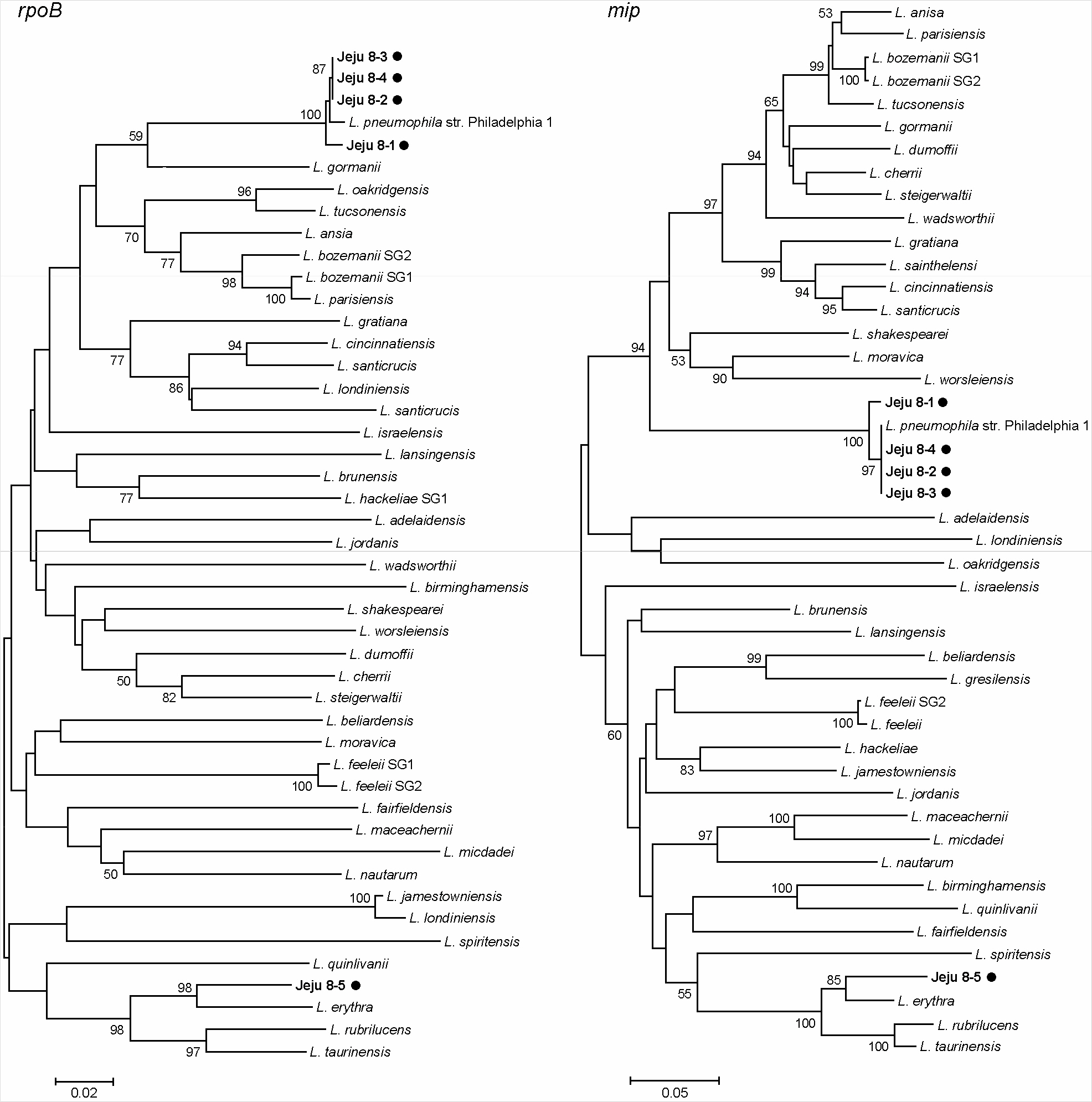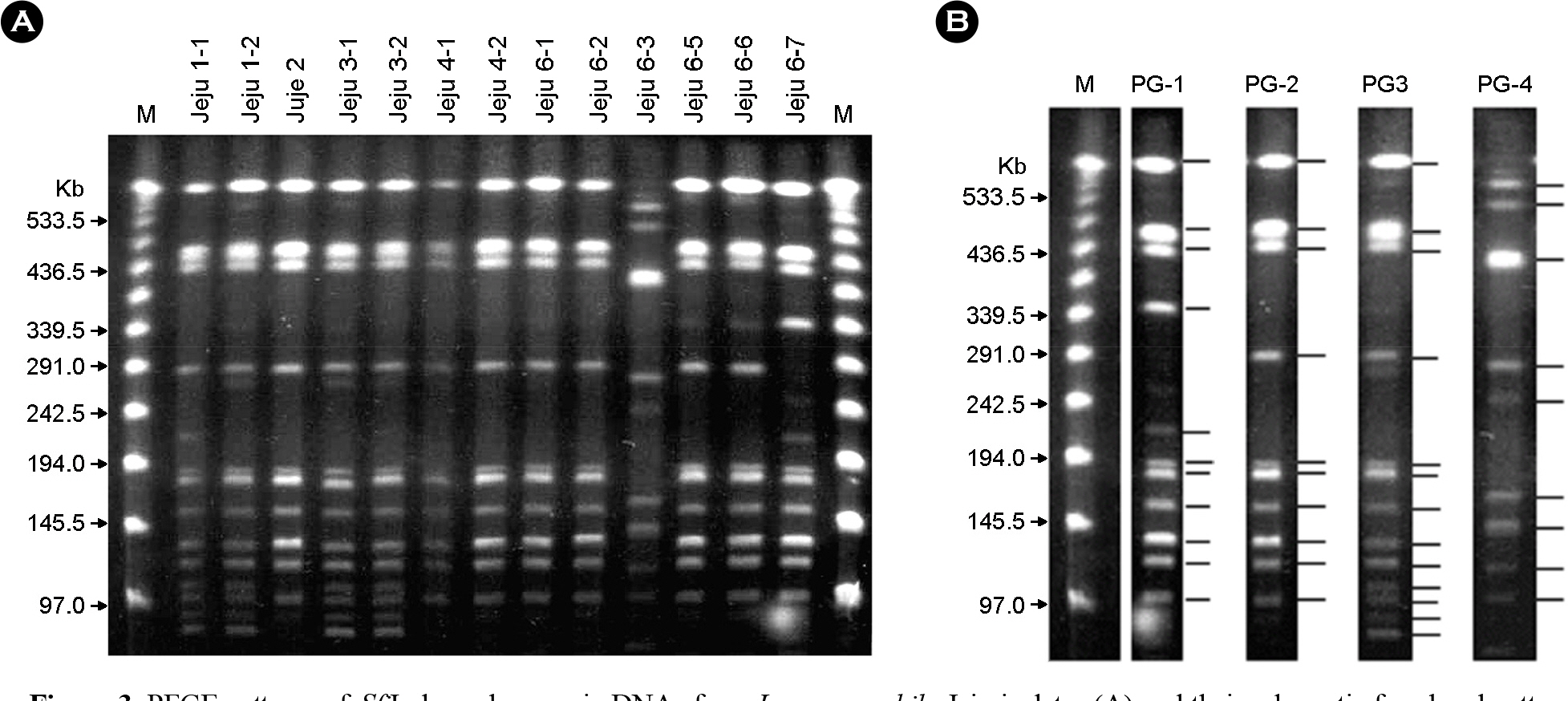J Bacteriol Virol.
2010 Sep;40(3):111-122. 10.4167/jbv.2010.40.3.111.
Molecular Genetic Typing of Legionella pneumophila Strains Isolated in Jejudo, Korea
- Affiliations
-
- 1Department of Microbiology and Immunology, and The Environmental Heath Center, Jeju National University School of Medicine, Jeju, Korea. yomust7@cheju.ac.kr
- 2Department of Microbiology, Seoul National University College of Medicine, and Clinical Research Institute, Seoul National University Hospital, Seoul, Korea.
- 3Institute of Environmental Resource Research of Jeju Special Self-Governing Province, Jeju, Korea.
- KMID: 2055048
- DOI: http://doi.org/10.4167/jbv.2010.40.3.111
Abstract
- Twenty two strains of Legionella species isolated from Jejudo, Korea were identified by comparing the rpoB (300 bp), dotA (360 bp), and mip (396 bp) gene sequence analysis. Furthermore, their genotypes were determined by sequence analysis of rpoB/dotA subgroup typing, pulse-field gel electrophoresis (PFGE) and random amplified polymorphic DNA (RAPD) patterns. Of the 22 isolates, 21 strains were identified as L. pneumophila and 1 strain was close to L. erythra (>95% similarity of rpoB and mip). Most of the L. pneumophila strains (90%) belonged to P-I of rpoB/dotA subgroup typing, one strain of each P-III and P-IV. L. pneumophila isolates were further grouped into 4 and 6 different PFGE (P1 to P4) and RAPD (R1 to R6) patterns, respectively. On the basis of these genotypes, which may be useful for future epidemiological studies, existence of diverse L. pneumophilla population in Jejudo, Korea were observed.
Keyword
MeSH Terms
Figure
Reference
-
1). Winn WC. Legionella. In. Murray P. R., editor(ed.),. Manual of Clinical Microbiology. 9th ed.American Society for Microbiology;Washington, D. C.: ),. 2007.2). Harb OS., Gao LY., Abu-Kwaik Y. From protozoa to mammalian cells: a new paradigm in the life cycle of intracellular bacterial pathogens. Environ Microbiol. 2000. 2:251–65.3). Fraser DW., Tsai TR., Orenstein W., Parkin WE., Beecham HJ., Sharrar RG, et al. Legionnaires' disease: description of an epidemic of pneumonia. N Engl J Med. 1977. 297:1189–97.4). Atlas RM. Legionella: from environmental habitats to disease pathology, detection and control. Environ Microbiol. 1999. 1:283–93.5). Benin AL., Benson RF., Arnold KE., Fiore AE., Cook PG., Williams LK, et al. An outbreak of travel-associated Legionnaires disease and Pontiac fever: the need for enhanced surveillance of travel-associated legionellosis in the United Sates. J Infect Dis. 2002. 185:237–43.6). Benkel DH., McClure EM., Woolard D., Rullan JV., Miller GB Jr., Jenkins SR, et al. Outbreak of Legionnaires' disease associated with a display whirlpool spa. Int J Epidemiol. 2000. 29:1092–8.
Article7). Correia AM., Goncalves G., Reis J., Cruz JM., Castro e Freitas JA. An outbreak of legionnaires disease in a municipality in northern Portugal. Euro Surveill. 2001. 6:121–4.
Article8). Den Boer JW., Yzerman EP., Schellekens J., Lettinga KD., Boshuizen HC., Van Steenbergen JE, et al. A large outbreak of Legionnaires' disease at a flower show, the Netherlands, 1999. Emerg Infect Dis. 2002. 8:37–43.
Article9). Fernandez JA., Lopez P., Orozco D., Merino J. Clinical study of an outbreak of Legionnaire's disease in Alcoy, Southeastern Spain. Eur J Clin Microbiol Infect Dis. 2002. 21:729–35.10). Formica N., Tallis G., Zwolak B., Camie J., Beers M., Hogg G, et al. Legionnaires' disease outbreak: Victoria's largest identified outbreak. Commun Dis Intell. 2000. 24:199–202.11). Jansa JM., Cayla JA., Ferrer D., Gracia J., Pelaz C., Salvador M, et al. An outbreak of Legionnaires' disease in an inner city district: importance of the first 24 hours in the investigation. Int J Tuberc Lung Dis. 2002. 6:831–8.12). Miyamoto H. Prevention measures against Legionella infection in a circulating hot water bath. J UOEH. 2003. 25:61–77.13). Kim JS., Lee SO., Shim HS., Oh TK., Cho MK., Oh HB, et al. An outbreak of legionellosis in ICU of K Hospital, Korea. Korean J Epidemiol. 1985. 7:44–58.14). Choe KW., Kim SM., Kim YS., Kim HJ., Woo JH., Chong YS. A case of Legionnaires' disease. Korean J Inf Dis. 1990. 22:93–6.15). Schoonmaker D., Heimberger T., Birkhead G. Comparison of ribotyping and restriction enzyme analysis using pulsed-field gel electrophoresis for distinguishing Legionella pneumophilla isolates obtained during a nosocomial outbreak. J Clin Microbiol. 1992. 30:1491–8.16). Thouverez M., Godard C., Leprat R., Talon D. Is pulsed-field gel electrophoresis a valuable tool to identify nosocomial cases of Legionella pneumophila disease? J Hosp Infect. 2003. 55:254–9.17). De Zoysa AS., Harrison TG. Molecular typing of Legionella pneumophila serogroup 1 by pulsed-field gel electrophoresis with SfiI and comparison of this method with restriction fragment-length polymorphism analysis. J Med Microbiol. 1999. 48:269–78.18). Costa J., Tiago I., da Costa MS., Veríssimo A. Presence and persistence of Legionella spp. in groundwater. Appl Environ Microbiol. 2005. 71:663–71.19). Lawrence C., Reyrolle M., Dubrou S., Forey F., Decludt B., Goulvestre C, et al. Single clonal origin of a high proportion of Legionella pneumophila serogroup 1 isolates from patients and the environment in the area of Paris, France, over a 10-year period. J Clin Microbiol. 1999. 37:2652–5.20). Sohn JW., Cheong HJ., Woo HJ., Kim WJ., Kim MJ., You SH, et al. A molecular epidemiological study on a cluster of Legionella pneumonia occurred in a tertiary-care hospital. Korean J Infect Dis. 1998. 30:218–26.21). Kim KY., Kim YS., Song JC., Lee SJ., Kim SU., Choi TY, et al. Comparison of methods for identification and the effects on Legionella pneumophila of the cooling towers in Seoul. J Korean Soc Occup Environ Hyg. 2003. 13:234–53.22). Kim JM., Kim KH., Song EJ., Lee SM., Lee EY., Park EH, et al. Molecular epidemiologic analysis of Legionella pneumophila by infrequent-restriction-site polymerase chain reaction. Korean J Clin Microbiol. 2006. 9:24–9.23). Park EH., Kim MH., Kim JA., Han NS., Lee JH., Min SG, et al. Molecular typing of Legionella pneumophila isolated in Busan, using PFGE. J Life Science. 2005. 15:161–8.24). Kim KB., Kim WJ., Kim MJ., Park SC., You SH., Shim HS, et al. A surveillance study of cooling tower water of large buildings in Seoul City for Legionella species with molecular analysis. Korean J Infect Dis. 1998. 30:207–17.25). Ko KS., Lee HK., Park MY., Park MS., Lee KH., Woo SY, et al. Population genetic structure of Legionella pneumophila inferred from RNA polymerase gene (rpoB) and DotA gene (dotA) sequences. J Bacteriol. 2002. 184:2123–30.26). Ko KS., Miyamoto H., Lee HK., Park MY., Fukuda K., Park BJ, et al. Genetic diversity of Legionella pneumophila inferred from rpoB and dotA sequences. Clin Microbiol Infect. 2006. 12:254–61.27). Kim BJ., Lee SH., Lyu MA., Kim SJ., Bai GH., Chae GT, et al. Identification of mycobacterial species by comparative sequence analysis of the RNA polymerase gene (rpoB). J Clin Microbiol. 1999. 37:1714–20.28). Ko KS., Lee HK., Park MY., Lee KH., Yun YJ., Woo SY, et al. Application of RNA polymerase beta-subunit gene (rpoB) sequences for the molecular differentiation of Legionella species. J Clin Microbiol. 2002. 40:2653–8.29). Park MY., Ko KS., Lee HK., Park MS., Kook YH. Legionella busanensis sp. nov., isolated from cooling tower water in Korea. Int J Syst Evol Microbiol. 2003. 53:77–80.30). Nielsen K., Hindersson P., Hoiby N., Bangsborg JM. Sequencing of the rpoB gene in Legionella pneumophila and characterization of mutations associated with rifampin resistance in the Legionellaceae. Antimicrob Agents Chemother. 2000. 44:2679–83.31). Pruckler JM., Mermel LA., Benson RF., Giorgio C., Cassiday PK., Breiman RF, et al. Comparison of Legionella pneumophila isolates by arbitrarily primed PCR and pulsed-field gel electrophoresis: analysis from seven epidemic investigations. J Clin Microbiol. 1995. 33:2872–5.32). Riffard S., Lo Presti F., Vandensech F., Forey F., Reyrolle M., Etienne J. Comparative analysis of infrequent-restriction-site PCR and pulsed-field gel electrophoresis for epidemiological typing of Legionella pneumophilla serogroup 1 strains. J Clin Microbiol. 1998. 36:161–7.33). Woo JH., Kim SA., Park CS., Choi TY., Chang IC., Lee IS. Nosocomial Legionnaire's disease–a case report and review of the literature. Korean J Intern Med. 1992. 7:68–72.34). Choi TY., Kim WB., Lee DW., Kang DY. Three cases of hospital-and community-acquired legionnaires' disease. Korean J Clin Pathol. 1993. 13:467–72.35). Choi HK., Lee CK., Lee DH., Kim YK., Lee KN., Kwon YJ, et al. Two cases of Legionnaires' disease in SLE patients with steroid therapy. Korean J Clin Pathol. 1997. 17:491–8.36). Jo SK., Shin JH., Jung KM., Kwon YJ., Kim MJ., Pyo HJ, et al. 2 cases of Legionnaires' disease with multiple cavitary masslike lesions in patients with systemic lupus erythematosus. Korean J Nephrol. 1998. 17:157–61.37). Kim KB., Kang MS., Chung HJ., Woo HJ., Kim MJ., You SH, et al. A case of fatal nosocomial Legionnaires' disease by Legionella pneumophila serogroup 1. Korean J Infect Dis. 1998. 30:106–10.38). Kim MJ., Cheong HJ., Sohn JW., Shim HS., Park DW., Park SC, et al. A prospective multicenter study of the etiological analysis in adults with community-acquired pneumonia: Legionella, Leptospira, Hantaan virus and Orientia tsutsugamushi. Korean J Infect Dis. 2001. 33:24–31.39). Urwin R., Maiden MC. Multi-locus sequence typing: a tool for global epidemiology. Trends Microbiol. 2003. 11:479–87.
Article40). Gaia V., Fry NK., Harrison TG., Peduzzi R. Sequence-based typing of Legionella pneumophila serogroup 1 offers the potential for true portability in legionellosis outbreak investigation. J Clin Microbiol. 2003. 41:2932–9.
- Full Text Links
- Actions
-
Cited
- CITED
-
- Close
- Share
- Similar articles
-
- Molecular Epidemiology of Legionella pneumophila Isolated from Bath Facilities of Public Establishments in Seoul
- Molecular Epidemiologic Analysis of Legionella pneumophila by Infrequent-Restriction-Site Polymerase Chain Reaction
- Molecular Strain Typing of Legionella Isolates from Water in Cooling Towers of Big Buildings in Busan, Korea
- A Molecular Epidemiological Study on a Cluster of Legionella Pneumonia Occurred in a Tertiary-Care Hospital
- A Surveillance Study of Cooling Tower Water of Large Buildings in Seoul City for Legionella Species with Molecular Analysis





